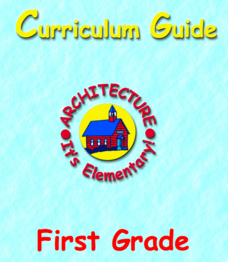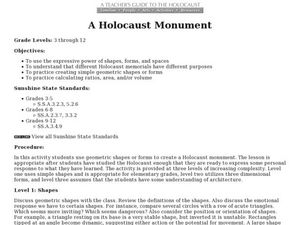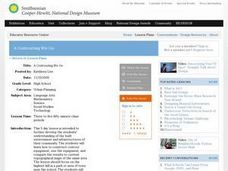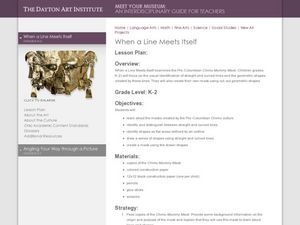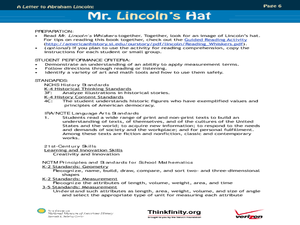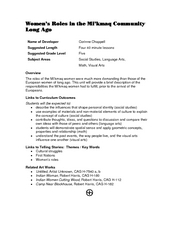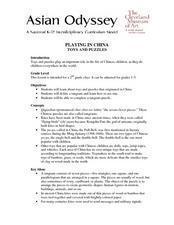American Institute of Architects
Architecture: It's Elementary!—First Grade
Build an interest and appreciation for architecture in your young learners with this fun 10-lesson art unit. Engaging children in using their five senses, the class first observes the environment around them, paying...
Yummy Math
Raspberry Chocolate Heart Cake
Have you ever finished a piece of cake and wished you had more? Solve this common dilemma with math! A straightforward worksheet prompts middle schoolers to use the given dimensions of a heart-shaped cake when planning to bake two larger...
Curated OER
Math Quilts
Students examine geometric shapes. In this geometric shape lesson plan, students examine how geometric shapes flip, turn, and slide to create a pattern. Students analyze the role that quilts played in helping slaves escape to freedom. ...
Curated OER
A Holocaust Monument
Students create a Holocaust memorial. In this interdisciplinary lesson, students use geometric shapes or forms to create a Holocaust monument.
Curated OER
A Holocaust Monument
Students examine Holocaust memorials to discover expressive power of shapes, practice creating simple geometric shapes or forms, and practice calculating ratios, area, and/or volume.
Curated OER
Identifying, Mapping, and Personifying Countries Involved in WWII
Get artsy with this WWII group activity, starting with a whole-class assignment. Create a map of Europe, Northern Africa, and the Pacific using geometric shapes cut from construction paper and placed on the floor. Consider splitting the...
Partnership for Educating Colorado Students
Mayan Mathematics and Architecture
Take young scholars on a trip through history with this unit on the mathematics and architecture of the Mayan civilization. Starting with a introduction to their base twenty number system and the symbols they used, this eight-lesson unit...
Curated OER
A Contouring We Go
Students examine the built environment and infrastructures of their community by constructing contour equipment, using the equipment, and comparing their results to current topographical maps of the same area
Curated OER
Mathematics of Ornaments and Architecture
Young scholars study African traditional architecture. They examine how African ornaments, wall painting and motifs use geometric shapes to express and explain the culture.
They discuss the ornaments and architectural designs in the...
Curated OER
Let's Make Lemonade
Young scholars respond to visual text. In this visual text lesson, students respond to the text, If God Gives You Lemons by making a poster advertising a lemonade sale. They listen to the story before decorating the posters with...
Edgate
Great Grids
Learners use grid boxes as a measurement tool and discover how grids are used for mapmaking and scaling down an area. They begin by attempting to draw a model shape drawn by the teacher by using the gridding process. At the conclusion of...
Curated OER
Traditional American Indian Lodges
Students explore the mathematical properties of traditional American Indian lodges. They examine the effect of increasing sides of a polygon, calculate the surface area of prisms and cylinders, and construct a classroom size pyramid...
Curated OER
When A Line Meets Itself
Learners investigate the linear characteristics of cultural art. In this art analysis lesson, students discover the Pre-Columbian Chimu culture and the many masks they created. Learners identify the different shapes and lines...
Curated OER
Mr. Lincoln's Hat
Bring out the inner artist with this Abraham Lincoln lesson. Elementary young scholars work on a home project creating a hat similar to Abraham Lincoln's hat. They will use geometry and measurement to create the scale of the hat, then...
Curated OER
Granary Door Dogon, Mali
Young scholars explore a creation myth. In this visual arts lesson, students discuss the Dogon creation myth and the design and make refrigerator magnets in the style of Dogan granary doors. The design of the magnets should include...
Curated OER
Once Upon A Time...
Students discuss elements of fairy tales, examine selected piece of Robert Harris' art, and compose fairy tales based on what they see and imagine. Students then view homes in Harris' artwork collection, create home in which they would...
Curated OER
That's Entertainment
Second graders view examples of active lifestyles in works of Robert Harris, and list and graph their daily activities to see if they lead active lifestyles. Students then name forms of entertainment that require practice,...
Curated OER
Countries Involved in World War II
Students create their own floor map of Europe, Northern Africa, and the Pacific. They locate, identify, and speak for one of the countries involved. In addition, they classify the country they represent as an Axis Power or as an Allied...
Curated OER
Land Use Change Unit Assessment
In this geography skills worksheet, learners respond to 33 multiple choice questions pertaining to land use and land changes.
Curated OER
Women's Roles in the Mi'kmaq Community Long Ago
Fifth graders examine the roles of Aboriginal women in their community long ago. They explore the different roles Aboriginal women portray in today's society. They address any stereotyping they may have regarding Aboriginal people.
Curated OER
Playing in China
Learners create their own Chinese tangrams using in-class direction and prior knowledge in this two-day instructional activity for the early elementary classroom. Chinese toys are also explored.
Curated OER
Ani-mania
Students view and discuss Robert Harris' farm landscapes and create their own mural out of wood. In groups, they discuss various issues affecting pets throughout the world and create a way to protest or celebrate the issue. They try to...
Curated OER
Totem Poles -- Storytellers of Long Ago
Third graders discover the main purpose for totem poles was to communicate with others. In groups, they compare and contrast the four types of totem poles and the various symbols used. They write their own stories based off of pictures...
Curated OER
Learning About Guatemala Through Its Kites
Students are introduced to Guatemala and to the tradition of giant kites. They decorate the kite sail and construct the kite. Students identifies possible causal factors contributing to given historical events.
